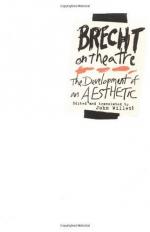
|
| Name: _________________________ | Period: ___________________ |
This test consists of 15 multiple choice questions and 5 short answer questions.
Multiple Choice Questions
1. _____ is a lament to man's failure to understand the laws governing his life in society.
(a) Die Mutter.
(b) The Threepenny Opera.
(c) Mahagonny.
(d) Galileo.
2. Brecht's first book of poems contained songs and _____.
(a) Sonnets.
(b) Limericks.
(c) Ballads.
(d) Haiku.
3. Subordinating one's own _____to what one imagines those intentions to be is one of Brechts 'common tendencies for actors to guard against'.
(a) Experience and observation.
(b) Soul.
(c) Reflection.
(d) Gifts and talents.
4. Who was in charge of Das Wort?
(a) Neher.
(b) Brecht.
(c) Scher.
(d) Bredel.
5. A mass of _____ to develop the character are carried out when it is introduced among other characters of the play.
(a) Interpretations.
(b) Digressions.
(c) Assumptions.
(d) Operations.
6. The actor first masters his character by mastering the _____.
(a) Gest.
(b) Stage.
(c) Lines.
(d) Story.
7. What signified a broad flow of popular musical elements into modern music?
(a) Avant-garde.
(b) Jazz.
(c) Blues.
(d) New Age.
8. Life of Galileo has the main character giving a boy a lesson on _____.
(a) The Bible.
(b) The solar system.
(c) Didactics.
(d) Color theory.
9. Epic theatre strives to achieve a character rather than a _____.
(a) Caricature.
(b) Dilettant.
(c) Corporal.
(d) Singer.
10. Brecht states that it is not the job of the Marxist-Leninist party to organize production of poetry as on a _____.
(a) Tomato farm.
(b) Factory floor.
(c) Ford assembly line.
(d) Poultry farm.
11. What is Creon's laurel wreath made of in Neher's Antigone?
(a) Copper.
(b) Cotton.
(c) Leaves.
(d) Wool.
12. What is Brueghel's great war painting called?
(a) The Fall of Icarus.
(b) The Archangel Michael.
(c) The Conversion of Saul.
(d) Dulle Griet.
13. Brecht states that the farmer was not aware throughout the centuries of his need for _____.
(a) Cows.
(b) The car.
(c) Irrigation.
(d) Marxism.
14. Where was Das Wort published?
(a) Moscow.
(b) Berlin.
(c) London.
(d) Paris.
15. What does Der Messingkauf mean in German?
(a) Twinkle Star.
(b) The Messy House.
(c) Taking Chance.
(d) Buying Brass.
Short Answer Questions
1. In Life of Galileo, Richard Gloster courts _____.
2. Art, to Brecht, addresses all alike and would confront the tiger its _____.
3. How does Brecht describe the confusion of styles present in European theatre in his time?
4. The Berliner Ensemble didn't believe in cutting new actors off from _____.
5. Brecht admits that his insistence on avoiding self-identification with a character is a _____ concept.
|
This section contains 366 words (approx. 2 pages at 300 words per page) |

|




